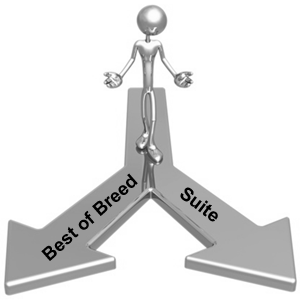 As companies make decisions about sourcing for new contact center technology, a crucial question to answer is whether to pursue “best-of-breed” (BoB) solutions or solutions that are part of a “suite.”
As companies make decisions about sourcing for new contact center technology, a crucial question to answer is whether to pursue “best-of-breed” (BoB) solutions or solutions that are part of a “suite.”
The BoB strategy was common when vendors had a more narrow focus. For example, there were “CTI vendors” or “IVR vendors” and “WFM vendors” or “QM vendors.” BoB worked well for larger companies with sufficient IT resources to manage integration and support.
Suite solutions appealed to small and medium companies wanting to go farther, faster, and to those without the internal resources to implement and maintain the complex BoB environment. Suite solutions became more affordable and provided capabilities previously unavailable to small and medium companies. Conceptually, the tradeoff was considered to be a complex BoB environment with advanced features or a more easily supported environment that might be missing some of the bells and whistles.
As companies of all sizes are driven by a desire to go far and fast with strained IT resources, suites have taken over the market on many levels. Yet even the definition of a suite has split into two categories: built as one and integrated into one.
“Built as one” are solutions built from the ground up as a single, total solution with one interface into all applications. For example, Interactive Intelligence introduced a single solution in 1994 with an “all-in-one” message that delivered broad functionality on a single platform. They started with PBX, ACD, IVR, and reporting and then expanded to WFM and QM. They continue to add functionality. Genesys has similarly built out a suite with extensive functionality, but from a different angle as they started as a best-of-breed CTI vendor. Some cloud solutions such as Five 9 and inContact have built out suites but tend to build the “core” functionality (multichannel ACD, IVR, CTI) and partner or purchase for WFO.
“Integrated into one” solutions rely on vendor integration, but often have multiple interfaces for system administration. These solutions are often the result of an acquisition strategy to add functionality to offerings in pursuit of the suite, especially for WFO elements. In some cases, an interface (or wrapper) to the various systems has been consolidated into a single view. An integrated solution does not always carry full functional capability of the original components. Examples of the integrated approach include Aspect and Mitel.
The suite concept has also expanded as vendors add to their product lines. Vendors may offer a total suite that meets all contact center needs or a subset where the different “suites” have to be integrated. For example, contact center vendors have a renewed focus on enterprise communications (aka “Unified Communications” or “Business Communications”) combined with contact center. Contact center and WFO vendors are increasing partnerships and level of integration with CRM or adding CRM and/or KM functionality. CRM vendors can manage all media except for voice.
Best-of-breed has evolved, too. Traditional BoB vendors have led the market in acquisitions, product expansion, and feature/function expansion such that most market leading vendors have become suites – or vendors of a suite of BoB products. For example, Verint and NICE are best-of-breed WFO solutions that offer a suite of components for a total WFO solution. As another example, there are analytics suites that are part of larger WFO suites that include desktop, text and speech analytics along with dashboards/scorecards for display.
Acquisition, innovation, and expansion among technology vendors have made sourcing distinctions increasingly complex. Moreover, struggles between IT and business biases and constraints on IT resources have forced contact centers to take more control over their destiny.
A thoughtfully constructed technology roadmap guides technology sourcing using a consistent approach. Even when a need – or opportunity – to deviate from the roadmap arises, management should take a moment to consider options and assess the tradeoffs, risks, and impacts.
